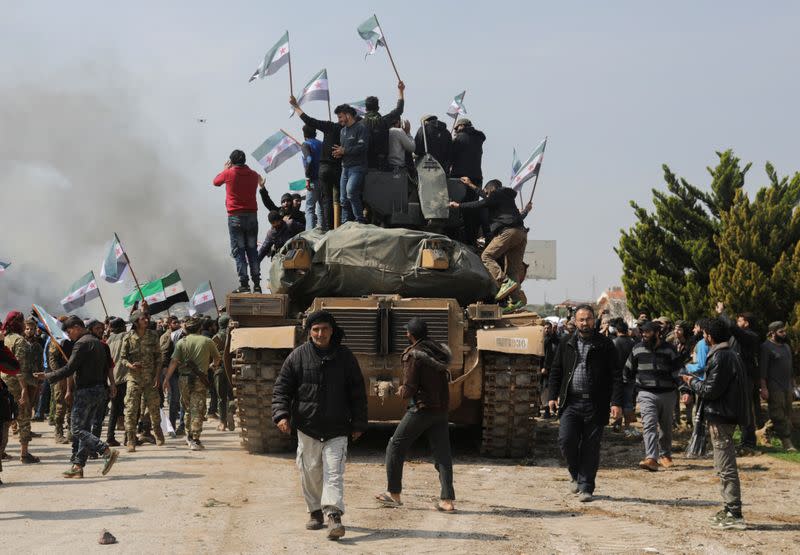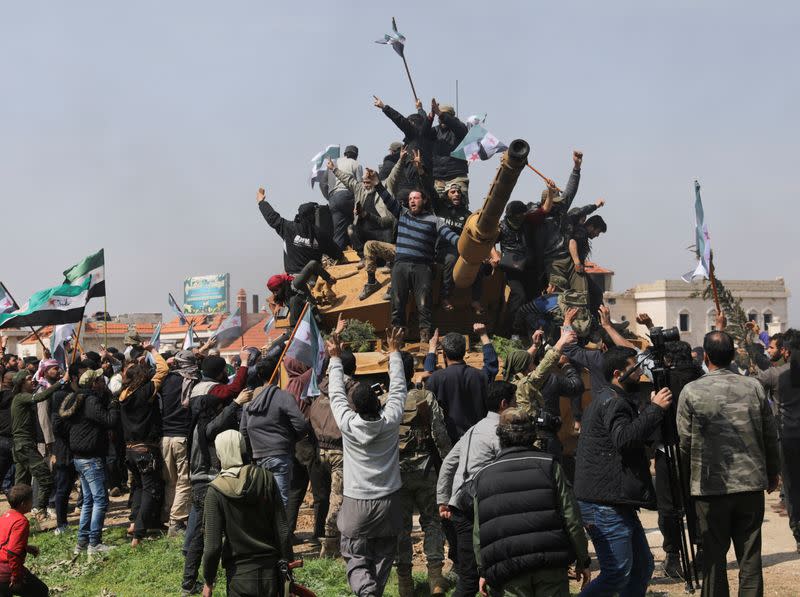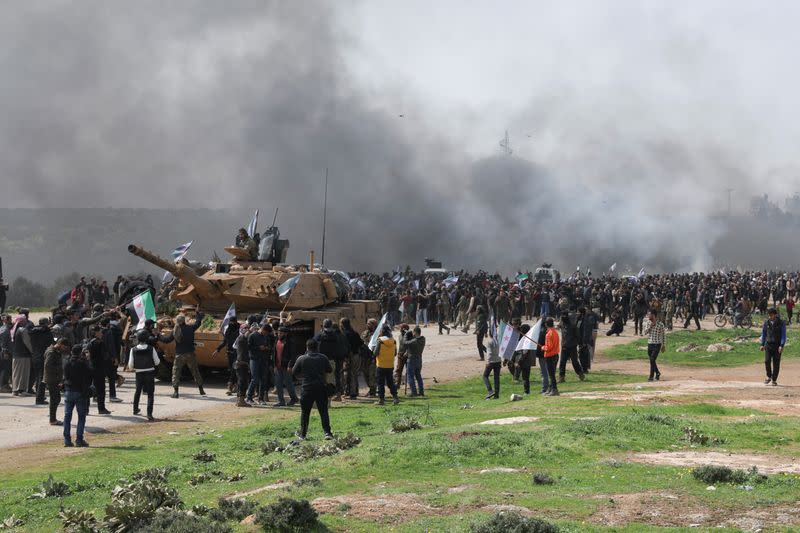The US might already be in a recession
Let’s just say it: The longest economic expansion in U.S. history may already be over, killed by Covid-19.

© Carlo Allegri / Reuters
Manhattan
It might seem crazy to talk about a recession when jobs are plentiful. Today the Bureau of Labor Statistics announced a decline in the February unemployment rate to 3.5%, tying a 50-year low.
But a recession isn’t when things are bad. It’s when they aren’t quite as good as they were at the peak. (Conversely, an “expansion” begins when the economy hits bottom and starts back up.)
When economic historians look back, they may pick February as the peak of the expansion that began in June 2009. That would give it a longevity of 128 months, the longest in records maintained by the National Bureau of Economic Research going back to 1854.
This wouldn’t be the first time the U.S. was in a recession without knowing it. In the summer of 2008 policymakers of the Federal Reserve were still predicting decent economic growth for that year and the next—even though a recession had begun the previous December, as later determined by the business cycle dating committee of the National Bureau of Economic Research.
The February jobs report that just came out is based on household and business surveys conducted in the week containing the 12th of the month. A lot has changed since then. On Feb. 12 there were still almost no cases of Covid-19 reported in the U.S. By March 5 there were 99, including 10 deaths, reported to the Centers for Disease Control and Prevention.
New research from State Street Associates and Massachusetts Institute of Technology indicates that the U.S. economy was vulnerable to a recession even before Covid-19 struck. In January the chance of recession over the next six months was about 70%, even though the stock market was then up about 22% over the previous year, it says.
The stock market’s sharp decline since January damages growth by making households feel poorer and businesses more pessimistic. The chance of a recession with stock prices where they were this week is around 75%, according to Will Kinlaw, a senior managing director and head of Cambridge, Mass.-based State Street Associates, the research unit of financial giant State Street Corp. If stocks give up all of their gains over the past 12 months, Kinlaw says, the likelihood of a recession will grow to 80%.
In addition to the stock market, the State Street Advisers forecasting model takes into account industrial production, the shape of the Treasury yield curve, and jobs. It’s based on a statistical concept called the Mahalanobis distance, which was developed to compare human skulls in India.
Covid-19 hit an economy that was less robust than it might have appeared. Nonfarm payroll employment was up 1.4% in January from a year earlier, which is OK. But industrial production was down 0.8% in January from a year earlier. And the Treasury yield curve was perilously close to inversion in January. (Inversion of the yield curve—in which long-term interest rates are lower than short-term ones—is a strong indicator of recession.)
The only strong indicator in January was the stock market, and now, thanks to the coronavirus, that indicator is flashing red as well.
While few economists have said the economy may already be in recession, some are beginning to say one is probably imminent. Mark Zandi, chief economist of Moody’s Analytics, says the chance of a recession this year is at least 50%.
In the financial markets, in contrast, recession talk is rampant. “This is what the start of a recession after a long bull market feels like,” John McClain, a portfolio manager at Diamond Hill Capital Management, told Bloomberg News today. “This is the first day of seeing some panic in the market.”
Kissing is frowned upon in the age of the coronavirus, but you might want to think about kissing goodbye to the longest economic expansion in U.S. history.
Read more: Coronavirus Could Cost the Global Economy $2.7 Trillion. Here’s How
Manhattan
It might seem crazy to talk about a recession when jobs are plentiful. Today the Bureau of Labor Statistics announced a decline in the February unemployment rate to 3.5%, tying a 50-year low.
But a recession isn’t when things are bad. It’s when they aren’t quite as good as they were at the peak. (Conversely, an “expansion” begins when the economy hits bottom and starts back up.)
When economic historians look back, they may pick February as the peak of the expansion that began in June 2009. That would give it a longevity of 128 months, the longest in records maintained by the National Bureau of Economic Research going back to 1854.
This wouldn’t be the first time the U.S. was in a recession without knowing it. In the summer of 2008 policymakers of the Federal Reserve were still predicting decent economic growth for that year and the next—even though a recession had begun the previous December, as later determined by the business cycle dating committee of the National Bureau of Economic Research.
The February jobs report that just came out is based on household and business surveys conducted in the week containing the 12th of the month. A lot has changed since then. On Feb. 12 there were still almost no cases of Covid-19 reported in the U.S. By March 5 there were 99, including 10 deaths, reported to the Centers for Disease Control and Prevention.
New research from State Street Associates and Massachusetts Institute of Technology indicates that the U.S. economy was vulnerable to a recession even before Covid-19 struck. In January the chance of recession over the next six months was about 70%, even though the stock market was then up about 22% over the previous year, it says.
The stock market’s sharp decline since January damages growth by making households feel poorer and businesses more pessimistic. The chance of a recession with stock prices where they were this week is around 75%, according to Will Kinlaw, a senior managing director and head of Cambridge, Mass.-based State Street Associates, the research unit of financial giant State Street Corp. If stocks give up all of their gains over the past 12 months, Kinlaw says, the likelihood of a recession will grow to 80%.
In addition to the stock market, the State Street Advisers forecasting model takes into account industrial production, the shape of the Treasury yield curve, and jobs. It’s based on a statistical concept called the Mahalanobis distance, which was developed to compare human skulls in India.
Covid-19 hit an economy that was less robust than it might have appeared. Nonfarm payroll employment was up 1.4% in January from a year earlier, which is OK. But industrial production was down 0.8% in January from a year earlier. And the Treasury yield curve was perilously close to inversion in January. (Inversion of the yield curve—in which long-term interest rates are lower than short-term ones—is a strong indicator of recession.)
The only strong indicator in January was the stock market, and now, thanks to the coronavirus, that indicator is flashing red as well.
While few economists have said the economy may already be in recession, some are beginning to say one is probably imminent. Mark Zandi, chief economist of Moody’s Analytics, says the chance of a recession this year is at least 50%.
In the financial markets, in contrast, recession talk is rampant. “This is what the start of a recession after a long bull market feels like,” John McClain, a portfolio manager at Diamond Hill Capital Management, told Bloomberg News today. “This is the first day of seeing some panic in the market.”
Kissing is frowned upon in the age of the coronavirus, but you might want to think about kissing goodbye to the longest economic expansion in U.S. history.
Read more: Coronavirus Could Cost the Global Economy $2.7 Trillion. Here’s How
















